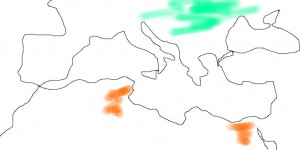As far as I can tell from the news coverage the protesters in Egypt have not anointed any individual or group to speak on their behalf. Whenever an opposition figure makes statements on behalf of the protesters, a regular reaction, at least in the Twittersphere, has been to deny that the figure should be understood as speaking on the protesters’ behalf. Given the decentralized nature of the protests, it’s hard to know how such an anointment process might even take place.
This presents an interesting set of dilemmas. On the one hand, it would seem to suit the incumbent regime just fine. If leadership is needed for well-coordinated strategic acts, then the atomistic nature of the protests limits the degree to which it can threaten the incumbent regime. If leadership provides focal individuals that can inspire steadfastness and sacrifice, then the atomistic nature of the protests means that its longevity depends on the sustained enthusiasm that each participant or small group of participants can muster themselves. If leaders are necessary to offer clear rebuttals to claims made by the incumbents, then the atomistic nature of the protests makes it easier for the incumbents to cast it in their preferred light and peel away support. For these reasons, we might expect the incumbent regime to do whatever it can from preventing the protesters from establishing a leadership. There is a certain “divide and conquer” element to this.
But things may cut the other way too. The rejection of claims to leadership that I read on Twitter seem to reflect a fear of letting anyone take up the mantle too early. Let me try to characterize what I interpret as a strategic rationale for this. The presumption seems to be that the establishment of a leadership will mark the end of establishing a bargaining position vis-a-vis incumbent forces and the beginning of bargaining, which inevitably means no more ground can be gained. So long as the atomistic movement is gaining ground, the logic might go, there is no need to settle on leaders yet. Given all the resources still at the incumbent regime’s disposal (including, it seems, the backing of the US), it would seem that if protesters agreed to have leaders begin bargaining for them now, they would end up with the short end of the stick. After all, when authority is delegated to a leader, that leader will look after the interests of those he or she represents to some extent, but will look after his or her own interests to the fullest extent. Knowing this, the incumbent regime may offer side deals that make the leader quite happy but sell the protesters short. To the extent that this captures what is going on, we have a classic “agency dilemma” (link).
As a protester, is time on your side in terms of the resources that incumbent leaders will have to co-opt whomever you put forward as a leader to bargain on your behalf? Or will the advantages that the incumbents gain by the lack of leadership on your side start causing you to actually to lose ground for your bargaining position? And how do you know, as a protester, that other protesters are looking at things the same way that you are? Pretty tough dilemma. It will be interesting to see if and how it is solved.


